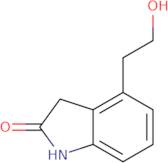4-(2-Hydroxyethyl)-1,3-dihydro-2H-indolin-2-one
CAS: 139122-19-3
Ref. 3D-FH24341
| 1g | Discontinued | ||
| 2g | Discontinued | ||
| 100mg | Discontinued | ||
| 250mg | Discontinued | ||
| 500mg | Discontinued |
Product Information
- 4-(2-Hydroxyethyl)-1,3-dihydroindol-2-one1,3-Dihydro-4-(2-hydroxyethyl)-2H-indol-2-one
- 1,3-Dihydro-4-(2-hydroxyethyl)-2H-indole-2-one
- 1,3-dihydro-4-(2-hydroxyethyl)-2H-indol-2-one
- 2H-indol-2-ONE, 1,3-dihydro-4-(2-hydroxyethyl)-
- 4-(2'-Bromoethyl)-1,3-dihydro-2H-indol-2-one
- 4-(2'-hydroxyethyl)-1,3-dihydro-2H-indole-2-ONE
- 4-(2-Hydroxyethoxy)Indole
- 4-(2-Hydroxyethyl)-1,3-dihydroindol-2-one
- 4-(2-Hydroxyethyl)-2-oxoindole
- 4-(2-Hydroxyethyl)indolin-2-one
- See more synonyms
- 4-(2-hydroxyethyl)-1,3-dihydro-2H-indol-2-one
- 4-(2-hydroxyethyl)-1,3-dihydro-2H-indolin-2-one
- Ropinirole Intermediate 5
- 4-(2-hydroxyethyl)oxyindole
4-(2-Hydroxyethyl)-1,3-dihydro-2H-indolin-2-one is an indole derivative that can be used as a dopamine receptor agonist. It has been shown to have dopaminergic activity and inhibit protein kinase A. 4-(2-Hydroxyethyl)-1,3-dihydro-2H-indolin-2-one binds to the dopamine receptor in the central nervous system by mimicking the action of dopamine in the body. The binding of this drug to the receptor causes conformational changes that leads to the activation of G proteins, which then activate adenylyl cyclase and increase levels of cyclic adenosine monophosphate (cAMP). This activation leads to increased protein phosphorylation and inhibition of cAMP breakdown. Analysis of this drug has revealed a crystal structure with intermolecular hydrogen bonds that are necessary for its function. This compound crystallizes in space group P





